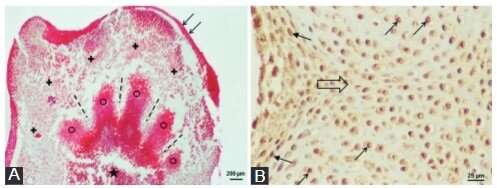This article has been reviewed according to Science X's editorial process and policies. Editors have highlighted the following attributes while ensuring the content's credibility:
fact-checked
trusted source
proofread
The role of global DNA methylation in rat limb bud development in vitro

A team of leading Croatian researchers at the Center of Excellence in Reproductive and Regenerative Medicine, Zagreb School of Medicine, has made a novel discovery in our understanding of limb development and DNA methylation, with potential implications for the field of regenerative medicine. The study's principal investigator, Vedrana Mužić Radović, along with senior researcher Ana Katušić-Bojanac, have led an innovative study titled: "Global DNA Methylation and Chondrogenesis of Rat Limb Buds in a Three-Dimensional Organ Culture System."
Limb development, which involves complex interactions between different cell layers and involves an intricate set of genetic regulation, is a four-dimensional process with constantly changing signaling cues. An integral part of this genetic regulation involves DNA methylation, a type of molecular modification that can change the activity of a DNA segment without changing the sequence itself. It has been found to be a crucial part of embryogenesis, postnatal development, and even adult tissue functions.
DNA methylation plays a dual role, sometimes leading to gene repression and other times leading to genome stability. It can either enhance or inhibit cell differentiation, and its deregulation can lead to serious developmental anomalies in mammalian limbs.
Understanding these processes is fundamental to the development of regenerative medicine, a field that seeks to develop methods to regrow, repair, or replace damaged or diseased cells, organs, or tissues. The team's findings, particularly regarding the dynamics of global DNA methylation during limb development, could pave the way for novel strategies in the manufacturing of cartilage grafts for osteochondral defects and give us a deeper understanding of diseases such as osteoarthritis and cancer.
For the purposes of their study, the researchers created a three-dimensional organ culture system, which provided an ideal setting for monitoring the complexities of limb development and DNA methylation dynamics. "Three-dimensional organ culture systems have a significant advantage over two-dimensional cell culture systems due to the presence of tissue interactions, which are essential for gene expression and the regulatory activity of mechanisms like DNA methylation," explained lead investigator Vedrana Mužić Radović.
Moreover, the experiments were conducted in chemically defined synthetic culture media—media that lacks animal ingredients such as fetal bovine serum. This media type is highly recommended for clinical applications, and it allows for more precise research into the inherent developmental potential of cells and tissues grown outside of living organisms (ex vivo).
This research represents a step forward in our understanding of the interplay between DNA methylation and limb development. Their findings confirm that in their original two-week organ culture system, early rat limb primordia develop further, and well-differentiated cartilage is present at the end of the two-week culture regardless of the explantation stage or the type of cultivation medium.
Interestingly, the researches found that a specific increase in the level of global DNA methylation was more associated with less developed limb organ primordia, whereas a decline in global DNA methylation was associated with more developed organ primordia. This suggests that global DNA methylation may play a role in determining the developmental stage of the limb primordia.
This novel work opens up new avenues in regenerative medicine and cell differentiation, expanding our understanding of the role of DNA methylation in development and disease. With further research, it could also lead to the development of novel strategies for the treatment of diseases such as osteoarthritis, cancer, and developmental anomalies, making this a promising step towards new therapeutic options for patients.
The authors elaborated on the significance of the study, stating, "Our research is not just about understanding limb development and DNA methylation but also exploring the possibilities this understanding opens up. By unveiling the dynamics of DNA methylation, we are one step closer to providing effective regenerative therapies that can significantly improve patient outcomes."
With further research, the team is optimistic about unveiling more facets of DNA methylation and its role in organogenesis. This could have transformative implications for developmental biology and regenerative medicine, providing valuable insights that could enable scientists and clinicians to navigate the complexities of genetic regulation and cellular differentiation.
Senior researcher Ana Katušić-Bojanac stated, "This is an innovative look at our understanding of global DNA methylation during limb development, a process so complex yet so crucial to the origin of life. This discovery could bring us closer to understanding the causes of many diseases and possible therapies."
In summary, this study published in Bosnian Journal of Basic Medical Sciences, represents an advance in our understanding of DNA methylation in limb development. It provides innovative insights that could potentially be important for novel strategies in regenerative medicine that address the production of cartilage grafts for osteochondral defects and a better understanding of diseases such as osteoarthritis, cancer, or developmental abnormalities.
More information: Vedrana Mužić Radović et al, Global DNA methylation and chondrogenesis of rat limb buds in a three-dimensional organ culture system, Bosnian Journal of Basic Medical Sciences (2022). DOI: 10.17305/bjbms.2021.6584
Provided by Association of Basic Medical Sciences of FBIH





















